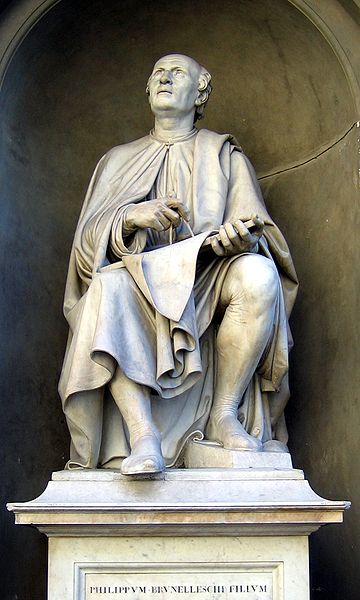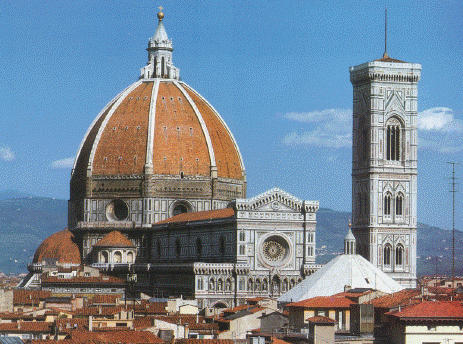I know that I regularly preach to my readers that we don’t know everything about history and how, sometimes, what we think we know is changed by the discovery of new information or new documents. I love it when that happens because I believe it wouldn’t be any fun if we really did know everything.
We actually know quite a bit about Filippo Brunelleschi (1377-1446) of Florence, Italy. We know that his father was a civil servant and that Brunelleschi traveled to Rome with Donatello, the famous Renaissance sculptor, and studied the local art and architecture. Brunelleschi was a true Renaissance Man, a goldsmith who was accomplished in sculpture, mathematics, engineering and ship design. But his greatest accomplishment was in architecture.

Statue of Filippo Brunelleschi near the “Duomo Santa Maria del Fiore” looking up to the Dome. Photo: Wikimedia Commons
Construction of Santa Maria del Fiore, generally known as the Florence Cathedral, began in 1296. The original architect had planned a dome, but nobody could figure out how to build it and by 1418 the dome had still not been completed. A competition was held to find who could build the dome and Brunelleschi, even though he didn’t present his plans, was the winner. Building began in 1420 and was completed in 1436; a span of 16 years that seems lightning fast when you consider it took 122 years to get to that point.
The problem was the engineering issues involved with building this 8-sided dome.
- The city of Florence specified that there would be no exterior buttresses (too cluttered), so the arches had to be self-supporting.
- Normally when building arches, wood was used as a framework to support the bricks until the structure was complete and the bricks and mortar could support themselves. In my research I learned that this method only worked about half the time, so the accepted protocol was to remove the wood and run in case the whole thing came tumbling down. Even if that method was foolproof and guaranteed to work, they didn’t have enough wood available to support it that way.
- They also didn’t have the wood for a complete scaffolding system for the workers laboring away more than 170 feet up.
For almost 600 years there were questions about how Brunelleschi managed to build this dome. Unlike a more famous Renaissance figure, Leonardo da Vinci, Brunelleschi did not leave behind any notebooks, designs or drawings. That loss could be completely accidental, but there are reports that Brunelleschi was very secretive and worried that others would steal his ideas or methods.
In 1989 Florentine architect Massimo Ricci started building a 1/5 scale model of the dome to test his theories of how Brunelleschi built the dome. He discovered that the secret is in the herringbone pattern of the bricks.
The other secret was discovered in the Florentine State Archives. There Ricci found an eye-witness sketch of the work being done on the dome, and that sketch included the pattern of the rope lines that were used to keep the eight sides of the dome symmetrical as they curved and met at the top.
Besides the sketch, there was another discovery in 2012. Underneath a parking garage being renovated, they were digging out years of landfill and found what may be Brunelleschi’s test dome. The time period and the herringbone match.
As usually happens, new discoveries can answer many questions, but not necessarily all of them. This particular story, if you’re not an architect, is much easier to understand with visuals. Luckily, PBS has an episode of NOVA called “Great Cathedral Mystery”. I highly recommend you check it out if you have any interest in Florence, the Renaissance, architecture, construction or masonry. Something for everyone.


My brother for years told me about his trips to Florence with his wife. The architecture definitely had it’s own history but my brother marveled about the artisans throughout the city. Leather shops were plentiful in the city. One drew them in. They walked past the shop and his wife was politely escorted inside by one of the owners. She was quite statuesque and before they knew it both owners were taking her measurements for a jacket. She found a style she liked and negotiated a price. One of the owners closed and locked the front door so as to not be disturbed by others while his partner brought out glasses of wine for them all to share. They came back to the shop the next day and shared more wine while finishing touches were made to the jacket. They make it a point to stop by the shop each time they travel to Florence. I was there in 2013 and marveled at the stylish doors throughout the city and the statues. We went to a Family owned winery/restaurant. We watched the chef prepare risotto and my friend decided she wanted to buy their wine. To make a long story short we couldn’t ship it so we put as much in our suitcases and drank the remaining 5 bottles the night before we left. I swore off wine for months after that.
New experiences and connecting with new people are the best parts of travel in my view. Those are the memories that last.
Thanks for sharing your story, Portia!